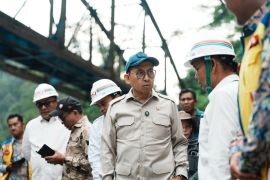"The Pulitzer Prize committee has honored one of our bravest and best photo-journalists, Massoud Hossaini."News York (ANTARA News/AFP) - Agence France-Presse won its first Pulitzer Prize on Monday as Afghan photographer Massoud Hossaini scooped up the honor in breaking news photography.
Hossaini, 30, was awarded a Pulitzer, the most prestigious US journalism prize, for his "heartbreaking image of a girl crying in fear after a suicide bomber`s attack at a crowded shrine in Kabul," the Pulitzer committee said.
Hossaini`s picture of an Afghan girl standing among a pile of dead bodies captured the devastation in the immediate aftermath of the attack on a Shiite shrine and was published in newspapers and on websites around the world.
Hossaini -- who joined AFP in 2007 -- was just meters (yards) away when the bomb went off on December 6, 2011, killing at least 70 people.
AFP chief executive Emmanuel Hoog congratulated Hossaini on winning AFP`s first Pulitzer.
"The Pulitzer Prize committee has honored one of our bravest and best photo-journalists, Massoud Hossaini, and the award is recognition of AFP`s insistence on quality and commitment across the range of journalistic pursuits," Hoog said. "Bravo and congratulations to Massoud.
"Today, in the news arena, words without images are impoverished and pictures without text are not enough," he said. "The two complement each other and images -- fixed or moving -- are essential to the journalism of the 21st century."
Hossaini, who is based in Kabul, said he was "so happy and excited" to win the prize that he was unable to sleep.
"I`m humbled to be an Afghan who can be a voice for the painful life and moments which people have here," he said. "I know that whoever sees this photo will think about the photographer but I hope they don`t forget the pain Afghanistan`s people have in their life."
In an interview with AFP conducted after his picture appeared on newspaper front-pages around the world, Hossaini described what happened that day.
"I was just looking at my camera when suddenly there was a big explosion," he said. "For a moment I didn`t know anything, I just felt the wave of the explosion as a pain inside my body. I fell down on the ground.
"I saw everybody running away from the smoke. I sat up and saw my hand was bleeding but I didn`t feel any pain," he said.
"It`s my job to know what is going on so I ran in the opposite direction to everybody else," Hossaini continued. "When the smoke went away I saw I was standing in the center of a circle of dead bodies.
"They were all together on top of each other. I was standing exactly where the suicide attacker had been."
Hossaini said he was in "shock" and initially "didn`t know what to do.
"I just started clicking," he said. "I know that I was crying. It was really weird crying, I`ve never reacted like that before.
"I didn`t help anybody, because I couldn`t, I was really in shock," he said. "I knew I should cover this, record everything, all the pain, the people running, crying, shouting, beating their chests, shouting: `Death to Al-Qaeda, death to the Taliban!`"
Hossaini said he turned to the right and saw the girl, Tarana, whose age has been given variously as either 10 or 12.
"When Tarana saw what had happened to her brother, her cousins, uncles, mother, grandmother, the people around her, she was just shouting," he said.
"She did a lot of things, but if you see my pictures she was just shouting. This shocked reaction was the main thing I wanted to capture," he said.
(U.B005/O001)
Editor: Priyambodo RH
Copyright © ANTARA 2012












